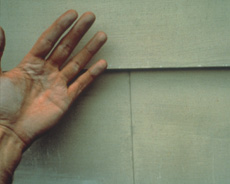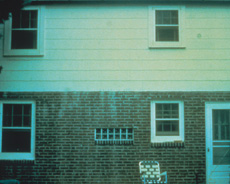 CHALKING
CHALKING
Formation of fine powder on the surface of the paint film during weathering which can cause color fading. Although some degree of chalking is a normal, desirable way for a paint film to wear, excessive film erosion can result from heavy chalking.
POSSIBLE CAUSES:
- Use of a low-grade, highly pigmented paint.
- Use of an interior paint for an outdoor application.
SOLUTION:
First, remove as much of the chalk residue as possible, scrubbing with a stiff bristle brush (or wire brush on masonry) and then rinse thoroughly; or use power washing equipment. Check for any remaining chalk by running a hand over the surface after it dries. If noticeable chalk is still present, apply a quality oil-based or acrylic latex primer (or comparable sealer for masonry), then repaint with a quality exterior coating; if little or no chalk remains and the old paint is sound, no priming is necessary.
 CHALK RUN-DOWN
CHALK RUN-DOWN
The washing down of chalk from an excessively eroding paint onto another area below (a brick foundation, for example), ruining its appearance (see Chalking).
POSSIBLE CAUSES:
- Use of a lower quality, highly pigmented paint.
- Use of an interior paint for an outdoor application.
- Erosion of factory-finished metal siding.
SOLUTION:
Remove as much of the chalk residue as possible (see Chalking). Scrub any stained areas with a stiff brush, using a detergent solution; rinse thoroughly. In cases of severe staining, an acid wash may be necessary. Either way, if the affected area dries to a different color, consider painting it with a quality latex paint. Eroding aluminum siding should be thoroughly cleaned (power washing recommended) before painting with a quality exterior latex paint.